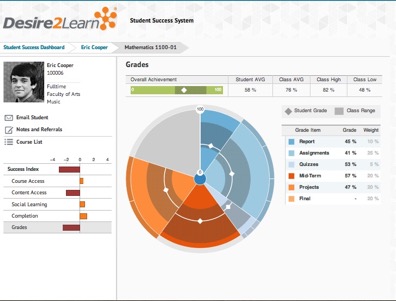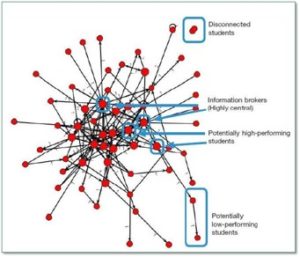Last week, eLIS instructional designers, John McCormick and Jaclyn Travis, presented a workshop for faculty on strategies for creating blended learning activities. Faculty worked through a problem cases together to come up with solutions for common instructional challenges. Below is the case of the missed lecture and a few potential solutions to the problem. Over the next couple of weeks we will review the cases and present potential solutions including strategies for preparing for snow days.
The Case:
Professor Sara Brown teaches an introductory level sociology course to undergraduate students. The course meets once per week for roughly 3 hours, and class time combines a mix of lectures, full-class discussion and group activities. In the third week of the course, Sara’s class is cancelled due to inclement weather.
Fortunately, there is no substantial group activity planned for week three, and Sara already has her students using BlackBoard for online discussion, so she feels they can easily make up missed class discussion time on the course site. However, in the lecture portion of week three, Sara planned to introduce fundamental, but rather complex, sociology concepts, and she strongly believes the students’ comprehension of course content will suffer if this lecture gets skipped.
How can Sara use the course site (and other online resources or tools if applicable) to deliver the lecture content to students? Also, how can he use the following week’s meeting to ensure this online piece is integrated with the rest of the course? Keep in mind that this lecture was supposed to contain complex content that some students may not be prepared to digest on their own.
The Problem:
Students have missed one week which includes lecture and full-class discussion. It is critically important that students gain an understanding of the lecture material, which includes complex sociology concepts.
It is important that the solution to this challenge include a way to check comprehension of the lecture, which the instructor has stated is very important to the course. It’s difficult to tell if and how the discussion activity was intended to integrate with the lecture for the week.
Solution(s):
The delivery of the lecture can be delivered in a similar way in the online environment. For example, she could use VoiceThread, which allows voice-over recording of slides. This is recommended over video recording of the instructor because of the difficulty in obtaining high-quality performances of a “talking-head” videos and because VoiceThread is based on slides that the instructor may already have created.
Checking lecture comprehension: There are several options available. Students could be required or allowed to ask questions based on the lecture, or in other ways respond to the content. This could happen online and/or in the next face-to-face meeting. A useful option may be to ask students to post responses or questions to the lecture, either within VoiceThread or within a dedicated discussion board or blog. Decisions on which tool to use for this depend on the number of students, the volume of the contributions, and the instructors’ comfort with the various tools. The responses and questions should give the instructor an initial idea of learners’ level of comprehension. The instructor could then plan the face-to-face follow-up with this knowledge. Depending upon the nature of the content and the instructor’s teaching style, she could then have students discuss the most challenging or misunderstood concepts and ideas in small groups or as a class, or she could ask them to write something brief that might serve as a comprehension check.
Discussion: The discussion could take place entirely online or could be blended across the two environments. As with all online discussions, the discussion prompt and guidelines will have to be outlined to help the discussion flow well without the constant presence of the instructor. One option is to create small online groups and have them post a summary to a separate discussion thread. The instructor can again use this information to plan a potential follow-up activity for the next classroom meeting. The face-to-face meeting could take the discussion deeper and the instructor can highlight or pull pieces of the online discussion as a catalyst for further in-class work.
Note: Giving credit for or grading required online portions of the work is good practice when blended learning. It shows that the instructor values time spent in the online environment.
 Many, if not all instructors have seen their students struggle to grasp or even fail to understand a concept important to progressing in a course or subject area. This type of learning block can derail a student’s development and have a ripple effect in their studies, particularly if that concept is a building block for future learning. These types of concepts have been identified by researchers in a UK national research project into qualities of strong teaching and learning in the undergraduate disciplines (Enhancing Teaching-Learning Environments in Undergraduate Courses). Erik Meyer and Ray Land, economics professors, found that certain concepts were held by economists that are central to mastering their subject, and that such “threshold concepts” had common features. The acquisition of threshold concepts has been likened to passing through a portal, where learners enter new conceptual territory. New ways of thinking or practicing, previously inaccessible, come into view for learners. Without these concepts, which often afford a transformed view of the subject landscape, students often cannot progress.
Many, if not all instructors have seen their students struggle to grasp or even fail to understand a concept important to progressing in a course or subject area. This type of learning block can derail a student’s development and have a ripple effect in their studies, particularly if that concept is a building block for future learning. These types of concepts have been identified by researchers in a UK national research project into qualities of strong teaching and learning in the undergraduate disciplines (Enhancing Teaching-Learning Environments in Undergraduate Courses). Erik Meyer and Ray Land, economics professors, found that certain concepts were held by economists that are central to mastering their subject, and that such “threshold concepts” had common features. The acquisition of threshold concepts has been likened to passing through a portal, where learners enter new conceptual territory. New ways of thinking or practicing, previously inaccessible, come into view for learners. Without these concepts, which often afford a transformed view of the subject landscape, students often cannot progress.



